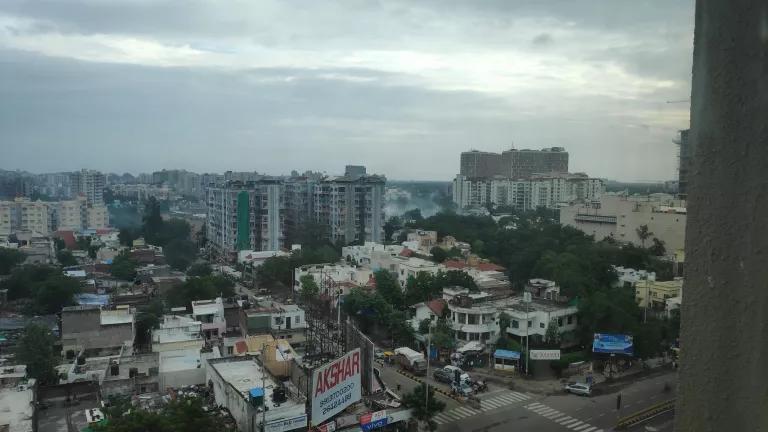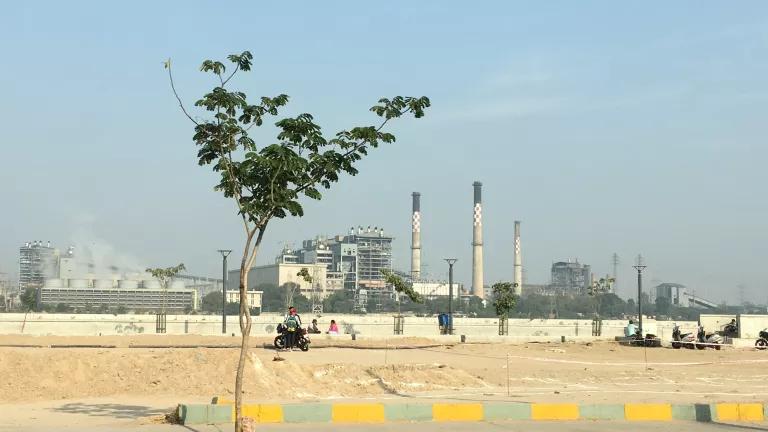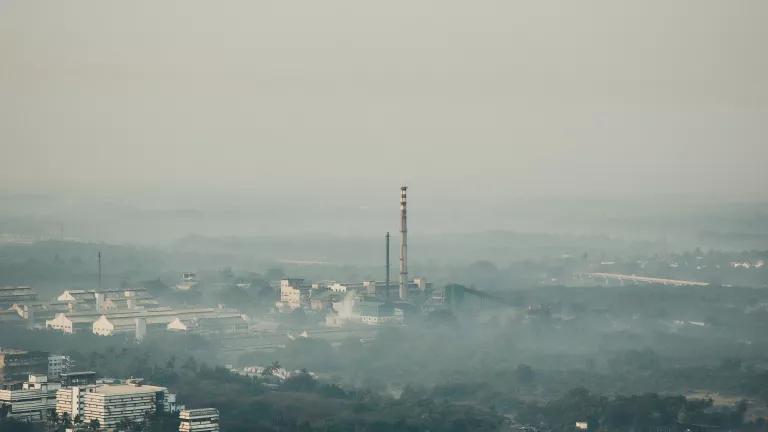New Health Report Urges Air Pollution Reduction in India
As climate change–fueled extreme heat and air pollution problems compound and intensify in India, coordinated mitigation solutions are needed to cut climate-warming emissions and reduce harmful air pollution exposures.

Pedestrians and a motorcyclist traveling a dusty road in India
Shobhit Pant
Guest blog by Polash Mukerjee and Jessica Korsh
Millions of people across northern and central India are struggling with extreme heat as temperatures approach 50 degrees Celsius (122 degrees Fahrenheit). The dangerous heat is affecting the country’s agriculture, energy security, and economic prosperity.
At the same time, a new report by the Lancet finds that ambient (outdoor) air pollution was responsible for 4.5 million deaths globally in 2019, up from 4.2 million deaths in 2015. Further, the report finds that more than 90 percent of all global pollution-related deaths occur in low-income and middle-income countries. Amplifying the urgent need for action, the report confirms that a massive rapid transition to wind and solar energy is needed to reduce outdoor air pollution and slow down climate change. Energy sector reforms to strengthen power utilities and accelerate an industry-wide transition toward cleaner, more efficient fuels can achieve multiple benefits: reduce dangerous air pollution, slow climate change, and improve public health.
Pollution threatens public health and prosperity
India continues to suffer from some of the worst air pollution in the world, and reducing its heavy burden is critical for the country’s long-term health and prosperity. Outdoor air pollution, largely from burning fossil fuels (coal, oil, and gas), was responsible for nearly one million early deaths in India in 2019. Fine particle pollution is a major public health concern because it can penetrate deep into the respiratory tract (disrupting heart and lung function) and cause irreparable respiratory harm, especially in children. In addition to tremendous health-related suffering triggered by air pollution, a 2020 study notes that economic loss due to lost output from premature deaths and morbidity attributable to ambient particulate matter pollution as a percentage of gross domestic product (GDP) in India was 0.84 percent in 2019, about Rs. 1.88 lakh crores or $22.8 billion.
Another air pollutant of public health concern is ground-level ozone, also known as smog. Ozone exposure causes breathing problems, triggers asthma, reduces lung function, and worsens lung diseases. Ozone pollution forms faster in warmer conditions. The Lancet report finds that 80,000 of the 370,000 global deaths attributable to outdoor ozone in 2019 occurred in India. And in 2019, the economic loss due to lost output from premature deaths linked to ambient ozone pollution as a percentage of GDP in India was 0.05 percent, about Rs. 11,000 crores or $1.4 billion.
Efforts to achieve India’s ambitious national renewable energy targets and widespread transportation electrification goals can address both the worsening climate crisis and enormous public health threats posed by air pollution. NRDC and local partners are responding to National Clean Air Programme targets by helping regional and city governments to develop sector-specific air quality management strategies for the city of Ahmedabad, Gujarat, as part of wider efforts to improve air quality nationally. Air quality interventions that cut harmful emissions in the short-term, such as cleaner power generation, transportation electrification, and fleet modernization, must be prioritized.
Clean transportation can drive down air pollution
Transportation electrification and vehicle fleet modernization are effective methods for improving air quality in Indian cities, according to scientific studies and the experiences of other countries. A thriving, clean electricity–based transportation sector in India can also create new jobs, reduce dependence on imported oil, improve air quality, and avoid climate-warming emissions. While electric two-wheelers have steadily gained traction in India over the last few years, the overall uptake of electric vehicles (EVs) has been slower than expected. Challenges to EV uptake include the high upfront cost and inadequate vehicle charging infrastructure.
To address these challenges, NRDC and local partners are working to develop solutions to scale up electric mobility and charging stations across India. Our how-to manual for siting EV charging stations, published in January 2022, details a stepwise approach to ensure the efficient and timely implementation of EV charging infrastructure. As a pilot project, NRDC and partners applied this framework for siting EV charging stations in a 2021 case study in Hyderabad, Telangana.
As climate change–fueled extreme heat and air pollution problems compound and intensify in India, coordinated mitigation solutions are needed to cut climate-warming emissions and reduce harmful air pollution exposures, especially for the most vulnerable people. As the new study points out, reducing pollution in India, particularly contaminated air (through reduced localized emissions from power generation, transportation electrification, and fleet modernization), is central to avoiding the worst climate-fueled health impacts in India in the years to come.
Polash Mukerjee leads NRDC's air quality work as a consultant based in New Delhi.
Jessica Korsh is a climate and health expert working as a consultant with NRDC.





